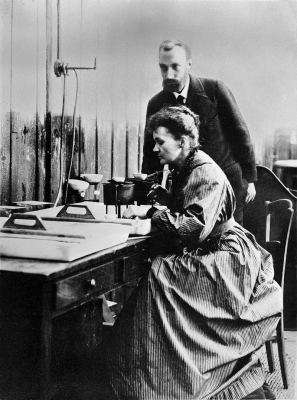
Marie Curie is a name that needs no introduction. A name synonymous with advances in sciences, she was particularly involved in the branch of radioactivity. Marie, in fact, is the only woman so far to have been awarded the Nobel Prize twice. After becoming the first woman to win a Nobel Prize in 1903, she won a second in 1911.
Marie shared her 1903 Nobel Prize in Physics with her husband, the French physicist Pierre Curie, and their colleague, the French engineer Henri Becquerel. While Becquerel was given half the prize, the other half was shared by the Curies. The Curies won this award “in recognition of the extraordinary services they have rendered by their joint researches on the radiation phenomena discovered by Professor Henri Becquerel”.
An intellectual affinity
Marie and Pierre met in the spring of 1894 and what started as an intellectual affinity soon blossomed into something more, as they married each other in 1895. What brought them together, kept them together, as the husband-wife duo teamed up professionally to deliver astounding results.
Becquerel paved the way for the Curies’ groundbreaking research by discovering radioactivity (a term later coined by Marie) in 1896. While most of the scientific community was fascinated by German engineer Wilhelm Roentgen’s recent discovery of X-rays, Becquerel’s discovery hadn’t aroused much attention. Marie, however, was drawn towards the idea and decided to make a systematic investigation.
It didn’t take her long to realise that thorium gave off rays just like uranium. She drew the conclusion that the ability to radiate must be linked to the interior of the atom itself and didn’t depend on the arrangement of atoms in a molecule.
A productive year
Even though Pierre had been working with crystals and magnetism since the early 1880s, Marie’s interest in radioactivity, and the results that she was getting, dragged him away from his crystals. Marie’s next idea was to study natural ores that contain uranium and thorium and she posited that a new element must be present in small quantities in the ore she studied on finding that it was far more active than the same amount of uranium.
By the end of June 1898, the Curies had discovered polonium, a substance about 300 times more active than uranium. The word “radioactivity” was used for the first time when they published about this work in July. By the end of the same year, they had grounds for having come upon another very active substance that they named radium. It was their colleague Becquerel who relayed the news about the discovery of radium to the French Academy of Sciences on December 26.
“Happiest years of their lives”
What followed was the arduous task of showing that they had indeed discovered new elements by producing demonstrable amounts of them, determining their atomic weights and even isolating them, if possible. Working out of a large unoccupied shed, the Curies laboriously isolated one-tenth of a gram of radium from one tonne of pitchblende. Even though the conditions in which they worked proved detrimental to their health, Marie later reminisced that “it was in that shed that they spent the best and happiest years of their lives”.
The Curies’ high of winning the 1903 Nobel Prize in Physics was tempered by the sudden death of Pierre in an accident in 1906. Marie, however, continued their work, and having devised a technique to separate radium from its residues, made it possible for it to be studied for its therapeutic properties.
Marie also took over her husband’s position as professor of general physics, becoming the first woman to teach at the Sorbonne University. After winning a second Nobel Prize in 1911, this time for chemistry, she went on to spend the rest of her life on their scientific work, including promoting the healing nature of radium.
Murray’s mistake
Radium was one among thousands of words that wasn’t included in the first edition of the Oxford English Dictionary and only made its way through a supplement that was produced in 1933.
It is believed that the lexicographers at Oxford were working on the fascicle ‘R’ to ‘Reactive’ at the time when the Curies coined the term “radium” for the element that they had newly discovered.
Even though this seems like a perfect moment to include the word in the dictionary, James Murray, a Scottish lexicographer and the first editor of what is now known as the Oxford English Dictionary, erred on the side of being cautious and decided against including it as he believed that the word might not last.
Murray, of course, was proven wrong as the Curies went on to win the Nobel Prize for their work, which included the discovery of radium.
Picture Credit : Google




